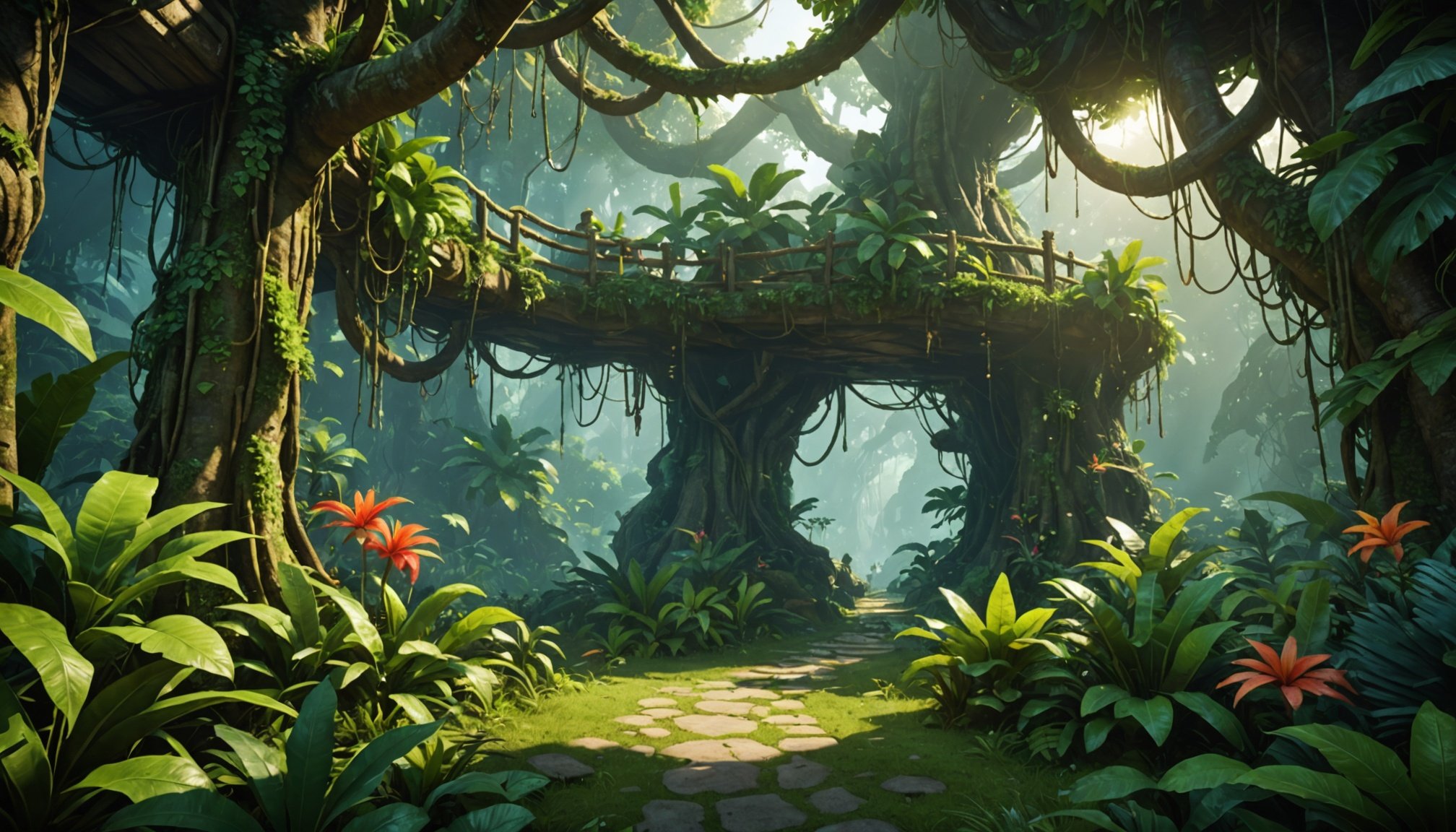Unlocking the Secrets of Lush Jungle Flora: Essential Tactics for Designing Captivating Immersive Exploration Games
Creating an Immersive World
When it comes to designing immersive exploration games, particularly those set in lush jungle environments, the key to success lies in crafting a world that feels alive, vibrant, and full of secrets waiting to be uncovered. Here are some essential tactics to help you achieve this:
Visual Realism and Detail
To immerse players in your jungle world, high-quality graphics are paramount. This includes realistic lighting, detailed textures, and accurate depictions of flora and fauna. For instance, the upcoming game “Weldiver” sets a high standard with its mesmerizing underwater environments, but similar attention to detail can be applied to jungle settings. Light filtering through the canopy, the sounds of exotic birds, and the rustling of leaves all contribute to an immersive experience[3].
This might interest you : Essential Elements for Crafting a User-Friendly Inventory System in Complex RPGs
Spatial Audio
Spatial audio is another critical element that enhances the sense of presence in your game. By changing sounds based on the player’s location, you can create a more realistic and engaging environment. For example, the sound of a waterfall should grow louder as the player approaches it, and the calls of different bird species should vary depending on the time of day and the player’s position in the jungle.
Interactive Elements
Players should feel like active participants in the world you create. This can be achieved through intuitive interactions such as hand gestures, voice commands, or eye tracking. In games like those using VR technology, these interactions can make the experience feel more real and immersive. For instance, in VR games, players can use hand controllers to manipulate objects, making the design highly intuitive and responsive[4].
In parallel : Transforming Historical Reenactment Games: Engaging AI-Driven Character Interactions for Authentic Experiences
Crafting a Compelling Story
A good story is the heart of any engaging game, and in the context of jungle exploration, it can be particularly compelling.
Narrative and Engagement
Interactive stories designed for immersive games can be powerful tools for engagement. By allowing players to make choices that impact the story’s outcome, you create a sense of agency and ownership. This can be seen in games like “The Long Dark,” where the player’s decisions in survival mode significantly affect their journey through the harsh wilderness[1].
Emotional Objective
Define the specific emotion you want to evoke through your story. Whether it’s fear, curiosity, or empathy, understanding this emotional objective helps you create a narrative that supports your theme or message. For example, if your game is set in a jungle filled with ancient ruins, you might aim to evoke a sense of awe and curiosity, guiding the player through a story that unfolds as they explore these mysterious sites.
Branching Narratives
Using branching narratives allows players to experience different paths and outcomes based on their choices. This technique not only empowers the player but also adds replay value to the game. In adventure games like “Final Fantasy VII,” the player’s decisions can lead to multiple endings, making the experience feel more dynamic and personal.
Designing Meaningful Interactions
Meaningful interactions are crucial for maintaining player engagement and enhancing the immersive experience.
Physical Actions and Gestures
In VR and other immersive games, physical actions replace traditional abstract controls. Players interact with the environment through movement, gestures, and hand controllers, making the design intuitive and responsive. For instance, in VR games, players can open doors, pick up items, or manipulate objects in a way that feels natural and immersive[4].
Seamless Animations
Animations must be smooth and responsive to maintain immersion. When a player turns their head or moves through the environment, the view should shift fluidly in sync with their motion. This can be achieved using motion capture technology, which tracks human movements and converts them into digital animations, allowing for lifelike and responsive interactions[4].
Balancing Realism and Performance
While creating an immersive experience, it’s essential to balance visual fidelity with performance to ensure the game runs smoothly.
Optimization Techniques
Techniques like Level of Detail (LOD) and Occlusion Culling can optimize performance without sacrificing visual quality. LOD dynamically adjusts the complexity of 3D models based on their distance from the player, while Occlusion Culling ensures that only visible objects are processed, reducing the system load[4].
Dynamic Lighting
Dynamic lighting can recreate effects like day-night cycles, flickering flames, or moving light sources, enhancing the atmosphere and immersion. Baked lighting, where lighting and shadow information is pre-calculated, can reduce processing demand during real-time gameplay, ensuring a smooth experience[4].
Practical Insights and Actionable Advice
Here are some practical tips to help you design a captivating immersive exploration game set in a lush jungle environment:
Start with a Strong Concept
Begin by conceptualizing your story and setting. Use brainstorming, mind maps, storyboards, and mood boards to outline your narrative, theme, setting, and characters. This will help you define the emotional objective and create a compelling hook that grabs the player’s attention[2].
Use High-Quality Assets
Invest in high-quality graphics, sound effects, and music. These elements combine to enhance the player’s sense of presence and immersion. For example, the sound of rain in the jungle or the rustling of leaves can create a vivid and engaging atmosphere.
Test and Iterate
Testing is crucial to ensure that your game meets the desired emotional and immersive objectives. Watch and listen to player feedback, use measurement tools like the Self-Assessment Manikin (SAM) or the Positive and Negative Affect Schedule (PANAS), and iterate based on this feedback to refine the experience[2].
Examples and Case Studies
The Long Dark
“The Long Dark” is an excellent example of how to create an immersive survival game. Set in a harsh, snow-blanketed wilderness, the game focuses on the fundamentals of survival rather than filling the environment with unnecessary elements. The atmosphere is fraught with tension, making hikes through the wilderness feel like real expeditions[1].
Among Trees
“Among Trees” offers a different take on survival games by focusing on relaxation and exploration. Players are dropped into a beautiful forest where they can build a cabin, grow food, and explore without the constant threat of danger. This game shows how survival can be imagined in a more peaceful and creative way[1].
Designing an immersive exploration game set in a lush jungle environment is a complex but rewarding task. By focusing on visual realism, spatial audio, interactive elements, and a compelling story, you can create an experience that draws players in and keeps them engaged.
Here is a detailed bullet point list summarizing the key tactics:
- Visual Realism and Detail: Use high-quality graphics, realistic lighting, and detailed textures to create an immersive environment.
- Spatial Audio: Implement spatial audio to change sounds based on the player’s location, enhancing realism.
- Interactive Elements: Use intuitive interactions such as hand gestures, voice commands, or eye tracking to make the experience feel more real.
- Compelling Story: Craft a narrative with branching paths and player choices to create a sense of agency and ownership.
- Meaningful Interactions: Design interactions that are in line with the emotional objectives, using physical actions and seamless animations.
- Balancing Realism and Performance: Optimize performance using techniques like LOD and Occlusion Culling, and employ dynamic lighting to enhance the atmosphere.
- Testing and Iteration: Test the game extensively and iterate based on player feedback to refine the experience.
Comparative Table: Key Elements of Immersive Game Design
| Element | Description | Example |
|---|---|---|
| Visual Realism | High-quality graphics, realistic lighting, detailed textures | Weldiver’s underwater environments[3] |
| Spatial Audio | Sound changes based on player location | The Long Dark’s wilderness sounds[1] |
| Interactive Elements | Intuitive interactions like hand gestures, voice commands | VR games using hand controllers[4] |
| Compelling Story | Branching narratives with player choices | Final Fantasy VII’s multiple endings |
| Meaningful Interactions | Physical actions, seamless animations | Among Trees’ building and exploration[1] |
| Balancing Realism and Performance | Optimization techniques like LOD, Occlusion Culling | Dynamic lighting in VR games[4] |
| Testing and Iteration | Extensive testing, feedback-based iteration | Using SAM and PANAS for emotional impact[2] |
By incorporating these elements and following the practical insights provided, you can create an immersive exploration game that transports players into the heart of a lush jungle, offering an unforgettable experience.











